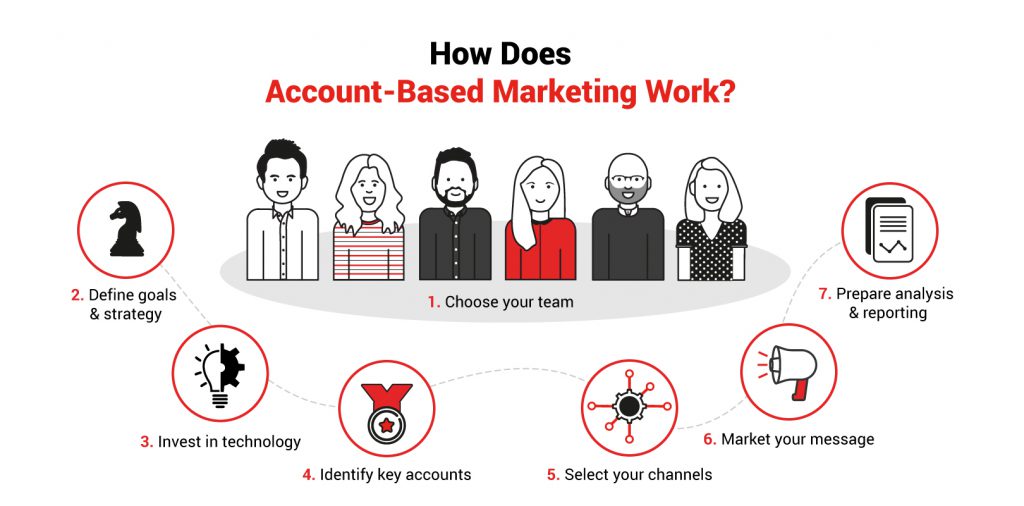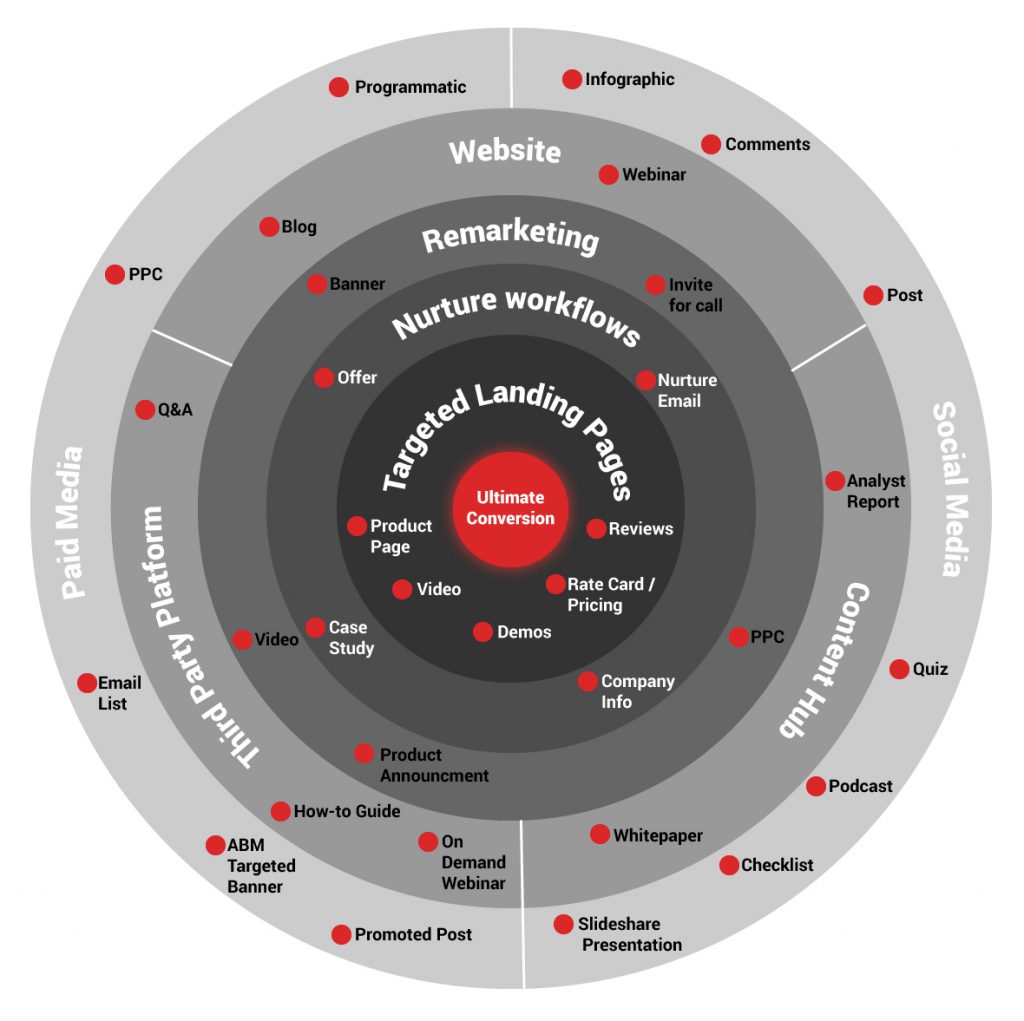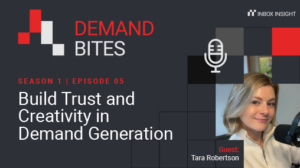These days, we see more B2B businesses turning to account-based marketing (ABM) as their go-to strategy with 88% claiming to see an improvement in conversion rates. Not only has GDPR immobilized the mass marketing trend, but industry is tiring of broad-based, high-volume, low-return schemes. Instead, marketing leaders want quality over quantity, and favor holistic methods for winning over their customers.
From saving on resources to improving conversion, there are many reasons to allocate time and budget to ABM. But how can you ensure you’re getting it right when you’re inexperienced with the ABM approach? Here’s a guide on how to run account-based marketing successfully.
Reading time: 14 minutes
What is account-based marketing and why should I care?
Account-based marketing has been around since the turn of the century, but has recently gained popularity with businesses seeking better ways to conduct their marketing and sales activity. It is an approach that focuses resources on a set of target accounts in order to achieve a greater percentage of wins. By analyzing the specific needs and attributes of existing clients, marketing teams can tailor their approach and deliver personalized campaigns to effectively boost upselling and cross-selling.
The idea is to get the most value from existing business accounts, and build meaningful, long-lasting relationships. While the main advantages of account-based marketing include a much faster sales process and a higher chance of success with minimal resource and outlay, the end goal is to become a trusted partner to many of your customers.
Here are the main benefits:
Shorter sales cycles
By targeting existing accounts, companies have a shorter sales cycle. To eliminate unqualified prospects early in the game, sales and marketing need to focus their time and energy on accounts that are most likely to convert.
Clearer path to ROI
There’s less risk with ABM marketing because it is targeted, precise and easy to measure. boast higher ROI for ABM compared to other marketing activities, which consistently helps teams to grow their accounts.
Targeted use of resource
A lot of campaigns require businesses to hedge their bets on multiple prospects, with little guarantee of moving them along the funnel. This can mean wasted resources and money. ABM on the other hand is targeted, using the least possible resource while bringing the highest rate of return.
Sustainable growth
Marketing to a set of key accounts helps organizations develop sustainable growth strategies. 49% of marketers use personalization technologies to achieve this holistic view of marketing, allowing them to go far beyond just lead generation. Instead, they build trust with top decision-makers and position themselves as a thought-leader or expert in their industry.
Encourages collaboration
Not only is account-based marketing fantastic for nurturing client relationships, but it can help build bridges internally too. This marketing concept requires sales and marketing to collaborate, creating a healthier workplace culture.
Simple reporting
ABM tends to cost more to implement than the blanket campaign approach, but it’s actually very cost-effective when you factor in success rates. And a huge pay-off for investing time and money in ABM is the analytics. With far fewer metrics to juggle, you’ll get accurate reporting that doesn’t take as much time to configure.
How does account-based marketing work?
Account-based marketing can be executed in a number of steps, and special attention will need to be placed on strategy, targeting methods and tactics, content development, and budgeting.

The steps involved in setting up account-based marketing are as follows:
1. Choose your team
First assemble your core ABM team, making sure to include people from sales, marketing and business development.
2. Define goals and strategy
Consider exactly what you want to accomplish with ABM and ensure all teams are aligned in goals and KPIs. Whether you want to launch a new product or service, execute a competitive takeout, build market share or penetrate a new one, everyone needs to be one the same page.
3. Invest in technology
ABM software makes it possible to do ABM at scale, connecting with contacts via digital channels and targeting entire accounts (not just individual leads). You can also leverage the technology to personalize campaigns based on past campaigns and CRM activity, personas, and their stage in the funnel.
4. Identify your key accounts
Create an ICP (ideal customer profile) to build your account list. At this stage, you will also need to make sure your business personas are defined to help you reach the diverse individual leads within these accounts.
5. Select your channels
Engage with the best-fit accounts on the channels they are most likely to use. It’s also important to look back historically at which channels have been the highest revenue drivers for your business.
6. Market your message
Once your carefully crafted message is out there, you can prepare your sales team for outreach. This is the time to engage in traditional methods such as email and phone calls. For long-running campaigns, marketing will also need to remain creative to refresh the key messages in order to prevent ad fatigue.
7. Prepare analysis and reporting
An analytical approach to ABM is necessary if you want to measure your success effectively. With actionable data, you can create a better experience for your buyers next time.
How to choose the right ABM strategy
When it comes to your strategy, there are three main ABM strategies to consider:
- One-to-one – this is the original and most effective strategy but only 14% of marketers use this approach. It involves specific individual accounts and personalized messaging, treating the most valuable accounts as individual markets. As an example, a typical one-to-one campaign may target around 5 to 10 of your key accounts.
- One-to-few – this strategy applies the original ABM principle to scale for campaigns that are aimed at a larger number of accounts. A one-to-few campaign focuses on small groups (rather than individuals) with messaging created from predictive analytics. 35% of marketers use this approach, which shows how it is a much more achievable strategy for many businesses.
- One-to-many – made for very large numbers of accounts, this approach is used by 16% of marketers and utilizes basic ABM at a much bigger scale. The average campaign may use firmographic data to determine an addressable market for outreach.
Choosing the right strategy is the most important step, so it’s vital to analyze the types of accounts you have in order to realize the best-fit approach. 35% of companies apply more than one strategy to ensure that their top accounts receive optimum personalization, while a broader campaign is used to reach other customers.
How to effectively target the right accounts
To target effectively, you will need to create a TAL (target account list). Combing through existing lists and identifying segments within your CRM is a great place to start. And by detailing an ICP, you can select the right audience characteristics and align the right customers for your campaign. You should also consider predictive software (utilized by 54% of marketers) and look-alike technology to find similar accounts that have been missed out in the process. This is crucial to keeping your account list fresh and relevant, in fact a huge 83% of marketers use look-alike strategies to expand their TAL.
After you’ve finished your list, you will need to make it operational with specific segments. Additionally, buyer intent data can gauge interest accurately. If you are unsure of how to do this, partnering with a provider could be the answer. This is becoming an increasingly popular option as more marketers want to upskill in the ABM space, leading 32% to work with a consulting partner. Just make sure you choose a specialist supplier who understands your target audience and can help you build a targeted list while running a demand generation program.
Which ABM tactics deliver the most success?
To establish the right tactics for ABM, you first need a better understanding of the type of channels you want to use. This will require knowledge of where your customers spend most of their time, and which channels bring back the greatest returns.
Cross channel engagement is a way of surrounding your audience with what they want to hear and using more than one platform to connect with them. Social, email, programmatic ads and telemarketing can all work together harmoniously to achieve the same end goal. In today’s digital world, where clients can be reached via multiple touchpoints, an integrated campaign is a must.

This process allows you to attract, engage and nurture through the funnel by driving your target audience into a content-rich environment, where your brand is able to have digital presence and provide value.
How ABM can flourish if it has the right content
Tailored content strategies are used by 53% of marketers but 19% are still using generic content with a broad appeal, so how do marketers conquer the content challenge in ABM? It can be hard to get right, especially when your in-house teams don’t have the skills or experience to execute a well-written campaign. A general guide is to keep the core of your message the same to align with your main narrative, but tailor lighter pieces such as guides, articles and ads to make it more relevant to segments.
If your campaign is broad enough (e.g. if it is a one-to-many strategy), create a library of content that is ready to be personalized for each account group. For more targeted strategies, you will need to take a more detailed approach to content development.
How do you allocate the right budget for the best ROI?
Finally, one of the key components of ABM that you can’t afford to ignore is how much budget to allocate. Although ABM has a much higher conversion rate than mass marketing techniques, it can be costly to implement – particularly for those who are inexperienced in these campaigns. However, the vast majority of businesses consider ABM to be worth their investment, with 48% reporting somewhat higher returns and 37% reporting significantly higher results compared to traditional B2B marketing.
This can often lead marketers to dedicate large chunks of their budget, with 36% spending more than 50% on ABM and 53% looking to increase spend in 2020.
A tip for low-risk spend is to focus on best-fit accounts, the ones that are most likely to convert and highest value. Then work out the maximum spend you can use to create the necessary outreach. Once you have allocated budget to those accounts, expand to look-alikes and use the remainder of your budget for persona-level targeting.
What are the key challenges of using ABM?
As with any methodology or approach, there are things that can go wrong if the right techniques are not put into place early on. Additionally, account-based marketing is only possible through excellent account awareness, and therefore requires sales teams and marketing teams to work together effectively.
Here are some of the main challenges and how to avoid them:
1. Not allocating enough budget
39% of marketers worry that they’re not able to allocate enough budget to make ABM truly successful as it can seem like a big risk putting all your eggs in a few baskets. However, the best way to make sure you’re getting a good return is to focus on best-fit accounts.
Top tip: Instead of launching into a grand ABM scheme, start small and expand later. 40% of marketers allocate 25-50% of their budget, while 22% allocate 10-25% of their budget.
2. Not being able to determine which accounts to target
Not knowing which accounts are the right ones to target is a key frustration for 39% of marketers. And getting it wrong has big consequences, as choosing your audience is the single most important step in any ABM campaign. An ICP can be a good place to start where you can review existing customers based primarily on firmographic, technographic and sociographic data.
What is firmographic data? Attributes that can be used to categorize organizations.
Firmographic data examples: geographic area, type of organization, industry, company size
What is technographic data? Profiling target accounts based on their technology stack
Technographic data examples: software being used, tools and applications being used, where in the implementation process
What is sociographic data? Looking at the individual
Sociographic data examples: job role, number of years in work, authority level
Top tip: Identify which accounts you would consider successful and create rules based on why; i.e. did the account spend a specified amount with you over the course of the year? How profitable were they? How many contact points were required before they converted? You can then use these benchmarks to help qualify accounts in future.
3. Unsustainable Target Account Lists (TALs)
Without the right targeting techniques in place, you could end up contacting the same decision-makers through multiple platforms and therefore garnering the same leads with twice the resource. There’s also the common pitfall of tunnel vision and not expanding the list thematically. Segmentation techniques such as firmographic data can be a great way to overcome this issue, giving you the tools to effectively assess and build your optimum TAL.
Top tip: Don’t rely on just one TAL, instead, create multiple TALs based on different segmentation criteria and plan a buyer journey that’s specific to each type of TAL you’re targeting.
4. Overlooking smaller decision makers
Having contacts at the top of the chain are ideal, but this doesn’t mean smaller job titles should be discounted when building you TAL. While direct budget holders, directors or C-Suite level managers can convert quickly with targeted campaigns, lower level executives are often necessary for opening doors or creating influence. Avoid reaching too far up the chain too quickly by addressing people at the early stages of the buying process. Timing is key, and the path up to the top has multiple stakeholders.
Top tip: Identify who the DMU is and develop personas for each individual within the buying center. You can then create content for each persona within the DMU to ensure maximum reach and improve the probability of a purchase.
5. Lack of collaboration between teams
Sales and marketing teams have traditionally acted as silos, and this has been problem for many businesses. For ABM to bring results, there needs to be a joined up approach; both sides need to be aligned towards the same goals, KPIs and metrics, while also ensuring seamless sharing of data and information. Be sure to treat ABM as a full funnel strategy, not just a marketing strategy, giving stakeholders across your company tracking throughout the campaign lifecycle.
Top tip: 80% of marketers have seen higher average deal size from ABM accounts compared to non-ABM accounts, so show sales teams how this type of strategy benefits them and can help them reach their targets faster. By demonstrating value to them, you’re more likely to receive team buy-in, and greater alignment as a result.
6. Not having the right content for campaigns
Identified as the biggest challenge for marketers, with 47% stating that delivering relevant content to target audiences is a big problem. This is extremely important for successful ABM, but many companies worry about getting their content right. Focusing budget and resource on a handful of accounts only brings back results if you make sure the content includes your key messages. Make sure what you deliver is relevant to the reader, personalized, and easy to understand.
Top tip: Look at what content has performed well on different channels in the past. Then, when creating new content, think about how you can distil what worked well before into what you’re doing now. Consider labelling each piece of content with a key purpose; why are you creating it? For what part of the funnel? For which buyer persona? This will help you focus your content creation efforts to produce something that is relevant for both the reader and the campaign.
7. Losing momentum during campaigns
Like many projects, it can be easy to lose momentum when campaigns are rolled out in stages. And 45% of marketers say this can be especially the case when results aren’t as expected the first time round. The best way to avoid stagnancy is ensuring clear market analysis and review of each campaign, and having clear steps to improve the next time round. Another reason for loss of momentum is the challenge of scaling up, but by choosing the right strategy from the start can help you scale in the way you need.
Top tip: Set yourself clear KPIs and objectives at the start of the campaign and schedule in review dates where you can track progress and forecast outcomes. Each time your review the campaign, set new goals or update current ones to keep you on track.






